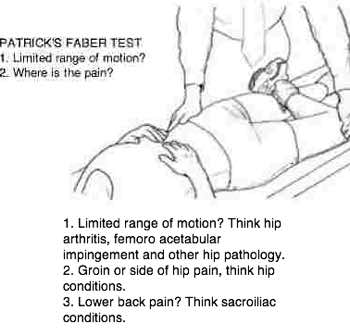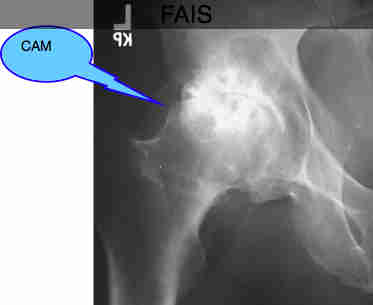- Home
- Hip arthritis
- Patricks faber test
Patricks Faber test

Patricks Faber test is a part of the basic chiropractic examination of the hip. Many conditions like arthritis, dysplasia and femoro acetabular impingement syndrome cause pain in the groin and upper leg; it often radiates to the knee.
When upper leg pain is neglected, it often changes the posture and gait, causing an added effect in the buttock and lower back; and then radiating down the leg.
It can become a diagnostic nightmare where the clinician struggles to decide whether this is primarily a hip problem radiating to the buttock and leg; or is it a lower back condition that is affecting the groin, femur and lower limb?
At a guess, I would say that around twenty percent of the letters that I get are related to hip issues. Medical doctors in the field, and some of my own colleagues, battle with pain in and around the upper leg and buttock. It's not always a pinched nerve in the spine.
Could it be a condition called meralgia paresthetica, where a branch of the femoral nerve is irritated both in the mid lumbar spine and the groin? It's the classic so called double crush syndrome.
Is it a Maigne's syndrome radiating to the groin? Perhaps it's a femoral nerve lesion from a lumbar facet or hot disc causing pain in the front of the thigh and around the inner knee and lower leg.
Or are we talking about a sacroiliac joint condition that frequently can radiate to the lower limb?
Add to that various medical conditions like an inguinal hernia, or even swollen lymph glands in the groin, and you have an oft unresolved diagnostic nightmare. Just today a letter from a woman with a five year history of such pain, unidentified and having great difficulty walking; she's not even fifty.
I hope you can grasp that pain in the upper thigh is a complex diagnostic area. Chiropractors may be myopic and see only biomechanical conditions that can cause groin pain. Equally the medical fraternity see everything in terms of inguinal hernias and lymphatic cancer.
The hapless patient find himself with pain in the upper thigh, perhaps also in buttock and back, and down in the lower leg, and no one is quite sure what the hell is going on. Five years later he can hardly walk.
Patrick's Faber test is an important part of the diagnostic examination.
The term Faber stands for
- Flexion
- Abduction
- External rotation
To do Patrick's faber test at home, lie on your back on your bed and place your foot on the opposite knee.
Since you have no idea what's normal, first to do Patrick's Faber test on your good leg.
Now, let your knee drop into the lotus position, noting well whether the hip is much stiffer, and the leg doesn't drop as far; also, do you get pain in the groin or outside of the hip?
Is there pain in the sacroiliac joint?
Since doctors of every ilk often haven't a clue what's causing your pain, doing tests like this may help to come to a correct diagnosis. Remember, fifty percent of doctors graduated in the bottom half of the class; I'm not being cynical. It's just reality and I miss diagnoses too; we all do.
This is a fundamental part of the examination of the patient with hip and groin pain; if Patrick's faber test wasn't done by your doctor, do yourself a favour and go elsewhere. He is either too busy to examine you properly, or hasn't a clue; either way, find yourself a new physician, be he or she, medical or chiropractic. Find someone who has the time and knowledge to be more thorough.
Patricks faber test & hip arthritis
Patricks faber test is to see if the problem is caused by hip arthritis or dysplasia or even femoro acetabular impingement.

A patient with a hip like this will have a very positive Patrick's faber test. The knee will simply be unable to drop down like the other leg. This is advanced hip arthritis caused by that CAM deformity.
Hip dysplasia
In the young person with hip dysplasia Patricks faber test will be normal, or may cause some pain in the groin, the range of motion will be full and even increased. However, as they age, the test will become more restricted and painful as the joint becomes arthritic.
Femoro Acetabular Impingement
It's not uncommon that small growths occur either on the cup or the neck of the hip; the range of motion is greatly reduced causing the stiff hip in the young adult. It has all the appearances on the physical examination of full blown arthritis, but no degenerative change is seen on the x-ray. Only a "pincer" or "CAM" deformity.
Untreated it progresses unerringly to hip arthritis. Early diagnosis is vital to prevent an early hip replacement. Patrick's Faber test will be strongly limited.
Hip arthritis
Hip arthritis doesn't usually come of itself; there's some underlying condition that caused it.
That could be trauma to the hip, and in a fall off a horse, or an MVA, or it could be due to a short leg. Research shows that a leg length inequality has a higher incidence of OA, in the knee too.
Then, both dysplasia and impingement syndromes in the hip lead to a much higher incidence if the condition isn't diagnosed early, and the joint exercised every single day. When Patrick's Faber test is positive, an x-ray of the hip is mandatory in my book.
Never neglect the limping child; see your chiropractor. Growing pains are in my opinion a medical myth, and the diagnosis simply used as a pretext to admit that we have no idea what the problem is. Growing pains chiropractic is an important part of clinical practice.
Perthes disease, undetected, leads inexorably to an early hip replacement, often in the thirties.
Chiropractic
Chiropractic is a form of treatment of joint and muscle conditions that often lead to nerve symptoms and signs. Manipulation, soft tissue therapy and rehab exercises are at the heart of the treatment.
A good examination using procedures such as Patricks faber test is fundamental.
Patrick's faber test
- Return from Patricks Fabere test to sacroiliac joint.
- Femoro acetabular impingement syndrome Pincer
- Developmental hip dysplasia
- Home
- Hip arthritis
- Patricks faber test
Did you find this page useful? Then perhaps forward it to a suffering friend. Better still, Tweet or Face Book it.
